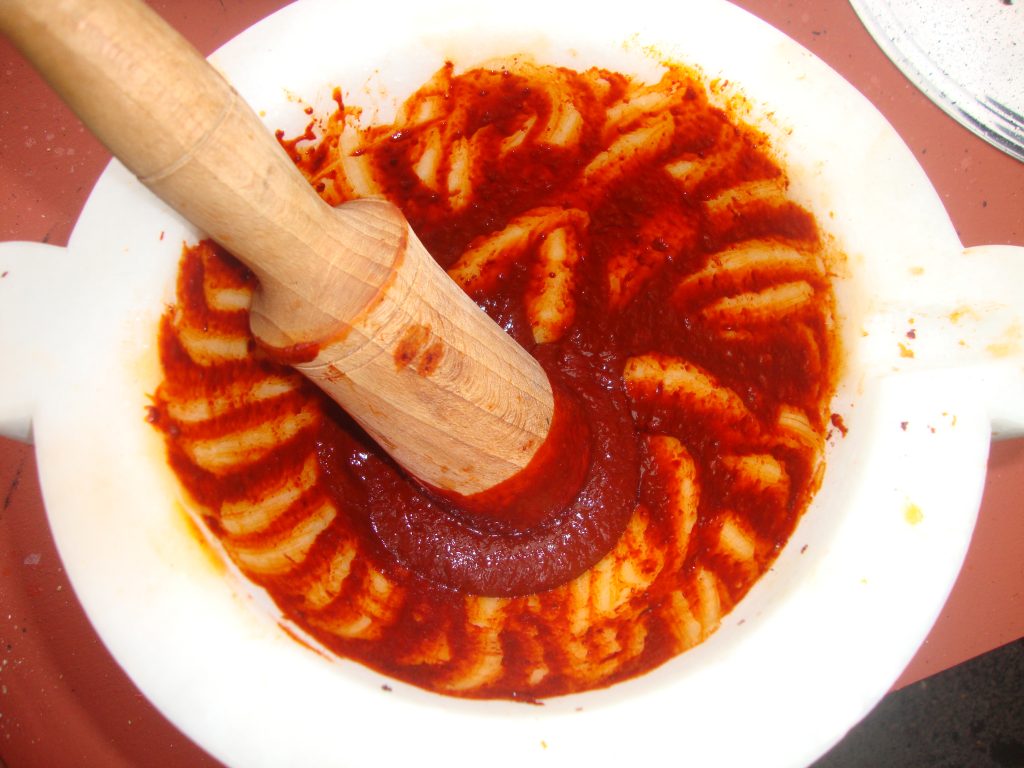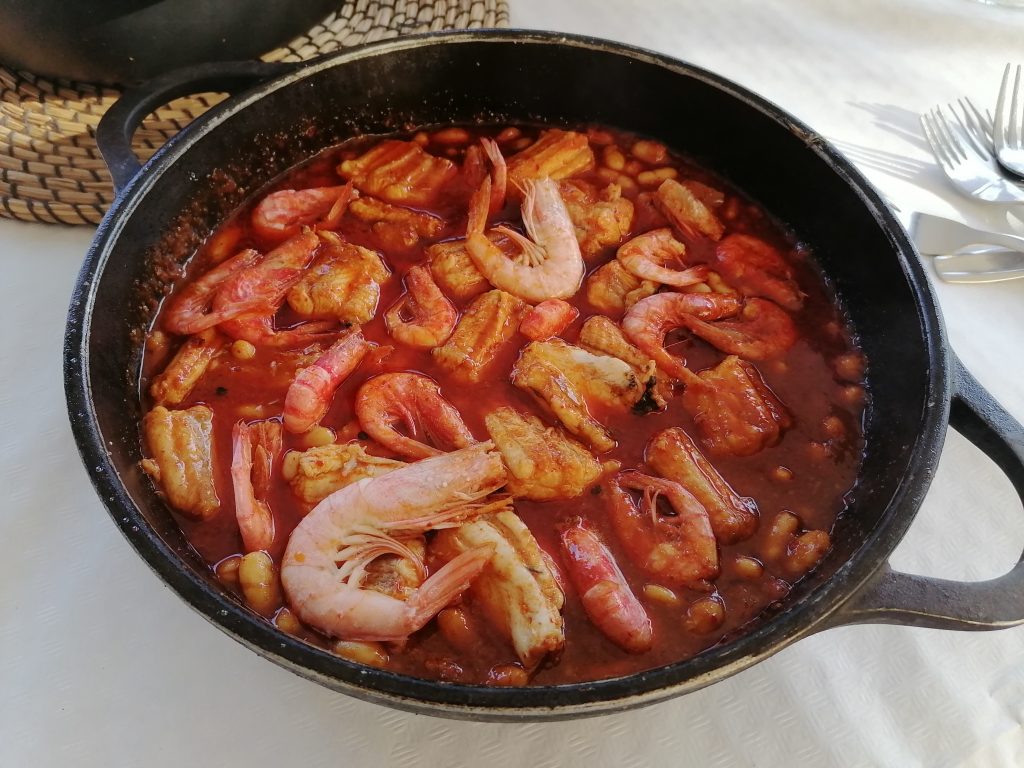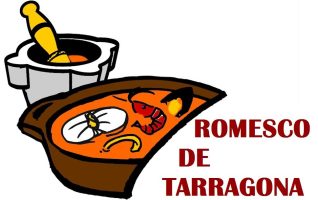In the gastronomic repertoire of many coastal towns it is common to find local fish stews, which are usually characterized by using local ingredients and also by having been developed by fishermen. Under this approach, it could be said that Tarragona has an autochthonous fish stew typical of its gastronomic tradition (the Romesco), which has its origin in the capital’s fishing district: the Serrallo.
Romesco is based on a mix of dried ancho pepper, almonds, hazelnuts, fried bread, garlic and, optionally, tomato and a little spicy dried red pepper. This mixture is fried in oil and forms the base of this unique stew. It is worth mentioning that the Costa Daurada has other stews related to the world of the sea, such as the Allipebre, the All Cremat, the Asmarris, the Suquet calero or the Groguillo, but the Romesco is surely the most native stew with the most personality.
However, the term «romesco» has become very popular related to a delicious cold sauce that is used to dress different dishes, sometimes sharing a table with aioli. This sauce is made with practically the same ingredients as the base of the stew, but adding oil and vinegar at the end of the preparation, in order to give it possibilities as a dressing. Given that the culinary use of this sauce is very different and in order to be exact, on this website -and following the tonic of Antoni Adserà in his 1981 book- two different meanings will be considered, so that it will be called Romesco to the stew, and romesco sauce to the cold dressing sauce.
The fact that willow and stew share the same name has generated a considerable confusion, and it is surprising to see how far it has been maintained over time. It is now necessary to consider to what extent and in what way are Romesco and romesco sauce related, a subject that can provoke an interesting debate.
Romesco and romesco sauce
It seems logical to admit that Romesco and romesco sauce are fully connected. Not only because they share the name, but also because they have a large part of their basic ingredients in common. However, a historical analysis of the Romesco does not easily deduce how to establish a concrete relationship between the two elaborations.
The romesco sauce probably derived in some way from the Romesco (stew), so that the stew would date from time before. One of the reasons that inspires this idea is that in El Practicón by Ángel Muro (1894), the book in which the first edited recipe for Romesco can be found, there is no mention at all about romesco sauce, despite the fact that Romesco interested a lot to this author, and also despite the fact that this book has an extensive chapter specifically dedicated to sauces with more than seventy recipes of very different preparations.
Art de ben menjar (Art of good eating), by Marta Salvià (pseudonym), became a classic of the catalan cuisine bibliography, being its first edition in 1923. In this book, in the section dedicated to cold sauces for meats or fish, there is a recipe for romesco sauce that the author suggests using with shellfish, crustaceans, snails and salads. The sauce thus differs from another recipe in this book called Bacalao con Romesco, a curious preparation that includes aioli[1].
In 1924, the famous chef and culinary popularizer Ignasi Domènech published a famous traditional cookbook: La teca. La veritable cuina cassolana de Catalunya (The chow. The true home cooking of Catalonia). This detailed and complete book includes a recipe for romesco sauce in its chapter on sauces, which, in another elaboration of the same book, the author suggests using it to garnish a barbecue of octopus or squid. Domènech also contributes various Romesco stew recipes in his book: fish, roast, veal heart and two versions of a rabbit Romesco.

In 1933, Ferran Agulló in El llibre de la cuina catalana (The Catalan cookery book) mentions two dishes from Romesco: one with fish and the other with chicken, the latter recipe that he proposes compatible with rabbit or hare. However, despite the fact that Agulló dedicates a chapter to the basic sauces of catalan cuisine, he does not mention romesco sauce. Antoni Alasà, in his book of 1951 dedicated to the Romesco, does not make any reference to romesco sauce; nor in his 1962 Tarragona cookbook (La cocina de mi tierra — The cooking of my land), although he does include two Romesco recipes (fish and bull with snails) in the latter.
In 1954, the chef and gastronomic writer Joan Cabané[2] pointed out in an article in Diari de Barcelona that by «romesco» you had to understand two things: the fish Romesco on the one hand and the cold sauce on the other. In Llibre dels Romescos (1963), Antoni Gelabert also explicitly mentions romesco sauce, although in this case he does so to question it, identifying it with an unfortunate derivative of Romesco, including the author in his disapproval a commercially packaged version of romesco sauce to which it refers, and which should already exist in 1963.
In 1981, in his book dedicated to Romesco, Antoni Adserà, he explicitly speaks of both the stew and cold sauce, publishing recipes for both preparations. Adserà highlights the broad common roots but advises to consider a double meaning of the term.
On the other hand, although Romesco is an undoubted part of the gastronomic tradition of the fishermen of Tarragona, there is not so much evidence regarding the use of romesco sauce in this context. It would not be the case with another exquisite cold dressing sauce called Balandra, similar to romesco sauce and which was most often part of the diet of local fishermen. Nor would the argument that romesco sauce could come from the traditional calçotades of Camp de Tarragona would be very resistant, since historically romesco sauce is not used in this aspect[3].
This interesting topic deserves a detailed and in-depth study that exceeds the objectives of this website. However, due to all the above, it could be suggested as a possible starting point that romesco sauce would have become popular from the 60s of last century, although probably not so much in the fishermen’s environment, but rather in the field of hostelry, posibly in a context of tourism development[4]. What is evident is that romesco sauce, unlike Romesco, has become very widespread in Catalonia, throughout all Spain and even in other countries, often under the abbreviated name of «romesco». For this reason, when references are made to Romesco (stew), it is often necessary to clarify in advance that is not refering to romesco sauce[5].
There are other sauces convergent with the romesco sauce and that have different applications in the gastronomy of Tarragona. Although this complex subject escapes the purposes of this website, some of them are mentioned below: salvitxada, more spicy and sometimes used to dress snails; the calçotada sauce, essential in the calçotada so typical of Camp de Tarragona and now so widely spread; the xató sauce, a basic ingredient of the xató from El Vendrell, also present in other areas; and one could also speak of a sauce typical of the faves a la brutesca, a dish not very well known but delicious, which could be considered similar to calçotada although using sheathed broad beans. All these sauces bear important similarities with romesco sauce, sometimes they receive the same name, and they could even be used interchangeably. However, it is worth trying to call each one by name, thus recognizing its own particularities[6].
The Romescos
It is also important to note that Romesco can actually be considered a collective term, in the sense that the ways of preparing this stew are very diverse depending on the ingredients and styles used. Thus, in the first instance we can speak of different fish Romescos; for example: Monkfish Romesco, Cuttlefish Romesco with potatoes, Sea Bass Romesco, Turbot Romesco or Cod Romesco (the latter has an especially typical recipe from the town of Santa Coloma de Queralt).
Different Romescos that are based on meat stews or other ingredients could also be mentioned, although many of these recipes have fallen into disuse: Romesco of bull with snails, Romesco of rabbit with snails, Tripe Romesco, cabbage with Romesco, omelette with Romesco… In any case, it should be taken into account that the aforementioned Romescos are always stews based on the mixed Romesco base, so that they should not be confused with dishes that are dressed with the (cold) romesco sauce.
At this point, it should be noted that this website will focus particularly on the Romesco (stew) and not so much on the romesco sauce (cold dressing sauce).
[1] The author Dionisio Pérez also mentions Bacalao con romesco in the section dedicated to catalan cuisine, in his Guía del buen comer español (Guide of good Spanish eating), from 1929.
[2] Joan Cabané was precisely the one who wrote the preamble to Antoni Alasà’s book, La cocina de mi tierra (The cooking of my land) (1962).
[3] El calçot i la calçotada, by Daniel Ventura. Quaderns de gastronomía, 1982 (catalan).
On the other hand, in Art de ben menjar (1923), Marta Salvià gives the recipe for a sauce for calçotada, but without mentioning that it is romesco sauce, despite the fact that in another section of this book she does offer an explicit recipe for romesco sauce.
Similarly, in la Teca. La veritable cuina Casolana de Catalunya (1924), Ignasi Domènech explains the recipe for Valls calçotada without mentioning the romesco sauce as a dressing, whose recipe he does write in another chapter of this book. He details this author the elaboration of another sauce specifically dedicated to calçotada, which he refers to as salvitxada.
In Antoni Alasà’s calçotada recipe in his 1962 book, he also offers a recipe of a specific sauce for calçots, and does not mention that it is romesco sauce.
Finally, in Antoni Adserà’s recipe for calçotada in his 1981 book, he describes a specific sauce to accompany calçots, although in this case he does explain that romesco sauce could also be used for this purpose.
[4] Assumpta Miralpeix, in her book Aqui hi ha teca! (2006), suggests that romesco sauce would be relatively recent with respect to Romesco (stew).
[5] David Solé in his book dedicated to Romesco (2003), suggested referring to romesco sauce as dressing romesco, in order to avoid confusion.
[6] Diferències entre la Salsa Calçotada Valls, el romesco de Cambrils, el xató del Vendrell, i la salvitxada, by Josep Maria Rovira. Cultura i Paisatge, 2020, number 12 (catalan).

